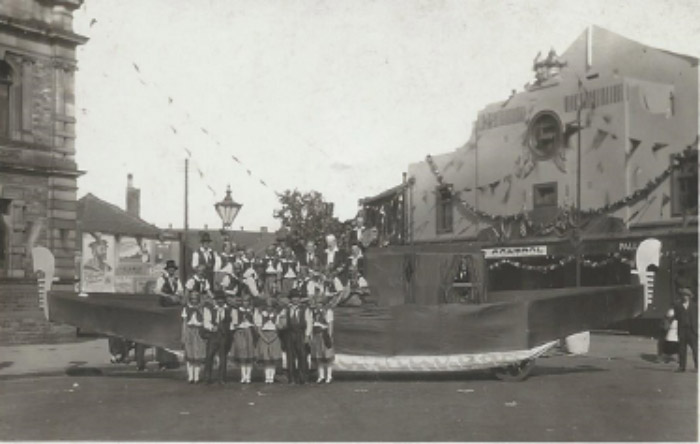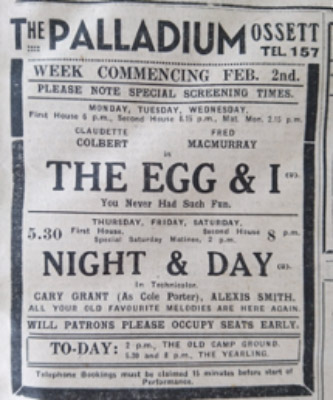
In 1910 the Town Hall, with its seating capacity of 700, was the first place in Ossett to be licensed under the Cinematograph Act 1909. Prior to the building of the Town Hall (the Meeting Hall section opened in November 1907), other venues used for cinematograph were the Drill Hall on Station Road and the Temperance Hall on Illingworth Street.
Now people’s lives had encompassed a weekly or sometimes twice weekly night at the ‘pictures’ and soon others with enterprise were entering the scene by constructing purpose built cinemas. In Town Hall Square, a site was obtained by the Newton Picture Palace Company and Ossett’s first and only cinema was built. This was the 846 seat Palladium Cinema. It opened its doors on December 22nd 1913 under the management of Mr. E.M. Hurst. The first film to be shown was the 1911, 18 minute long, silent movie “Greater Love Hath No Man”. Prices of admission were 2d, 4d and 6d.
The Temperance Hall with its “Peoples Popular Pictures” ran films at least into the war years, 1914 to 1918. It was not featured in trade lists for 1920 and it seems its lease passed at some period to the Newtown Picture Palace Co. Ltd., owners of the Palladium. In 1922, West Riding County Council General Purposes Committee refused to allow any more cinematograph licences for the Temperance Hall. Basically this left Ossett with just one full time cinema, The Palladium, thus it continued through that decade.

Procession 1930’s. The Palladium in the background. Players’ Capstan advertisment behind the Town Hall.
Around the early part of the war (1914-1918) the Palladium was managed by Mr. Archie Wilson. When he was called up to fight in the Great War, his step-mother, Mrs. E.F. Wilson, became the manager. As the roaring 1920s approached, prices ranged from 5d to 1/-. In 1921 a new modern telephone was fitted. The number was Ossett 157.
In around late 1930 the Palladium was fitted with a sound system, for “talkies”. Nearby Wakefield had set the pace for the area with The Playhouse going “talkie” from July 1929. The Palladium later fitted Western Electric sound. In 1932/33 the Palladium changed its usual policy and ran shows on the continuous principle. Admission prices increased and ranged from 4d to 1/6d. In around 1936, the cinema became The Palladium (Ossett) Ltd and the seating capacity was reduced to 680. The cinema continued to run through the WW2 years (1939-1945).
In August 1936, the Palladium was reopening after having had a face-lift. There was a new, modern appearance to the façade, with new steps, swing doors and a sense of freedom and spaciousness in the foyer. In the auditorium there were rich draperies and modern colour lighting. Architect Mr. L. Stanley Wright was responsible for the new look. Mr Kenneth Friese-Green was the contractor. He built some of the largest cinemas in the country. His father, William, was a pioneer of cinematography and colour photography.
 Palladium 1948 Programme. Ring Ossett 157 to book
Palladium 1948 Programme. Ring Ossett 157 to book
The “Ossett Observer” described The Palladium is as “a comfortable, pleasant building”, and noted that it was well ventilated with an electric fan in the roof and that it was warmed by a “hot water apparatus”. At that time, it could seat 800 principally on “plush-covered, tip-up seats”.
In around 1955, a form of Cinemascope had been fitted here. Cinemascope with its wide screen and “Epic” films in colour kept The Palladium going throughout a few more years.
Travel was now better and many folk went to Wakefield or elsewhere for their entertainment and earlier showings of films than was possible at Ossett’s small independent cinema. Like many suburban cinemas nationally, the smaller cinema relied on later films at cheaper rates of hire and also a local loyal clientele, but this patronage could not sustain them for long.
By the late 1950s, unable to compete with the new Cinemascope theatres offered in Wakefield and Dewsbury, and with the advent of television, The Palladium was beginning to struggle. Even the most loyal of local clientele couldn’t sustain the cinema for long. With regret, The Palladium closed its doors on the 29th April 1961. The last film shown was “The Miracle”, made in 1959, and starring a youthful Roger Moore with Carroll Baker as the leading lady.

Top Left: The interior of The Palladium. Top Right: The Palladium during demolition. Below: Hillards Supermarket was built on the site of The Palladium
The cinema was demolished in March 1962 and was replaced by a Hillards Supermarket. Jack Fultons shop is now located roughly where the Palladium previously stood.
References: